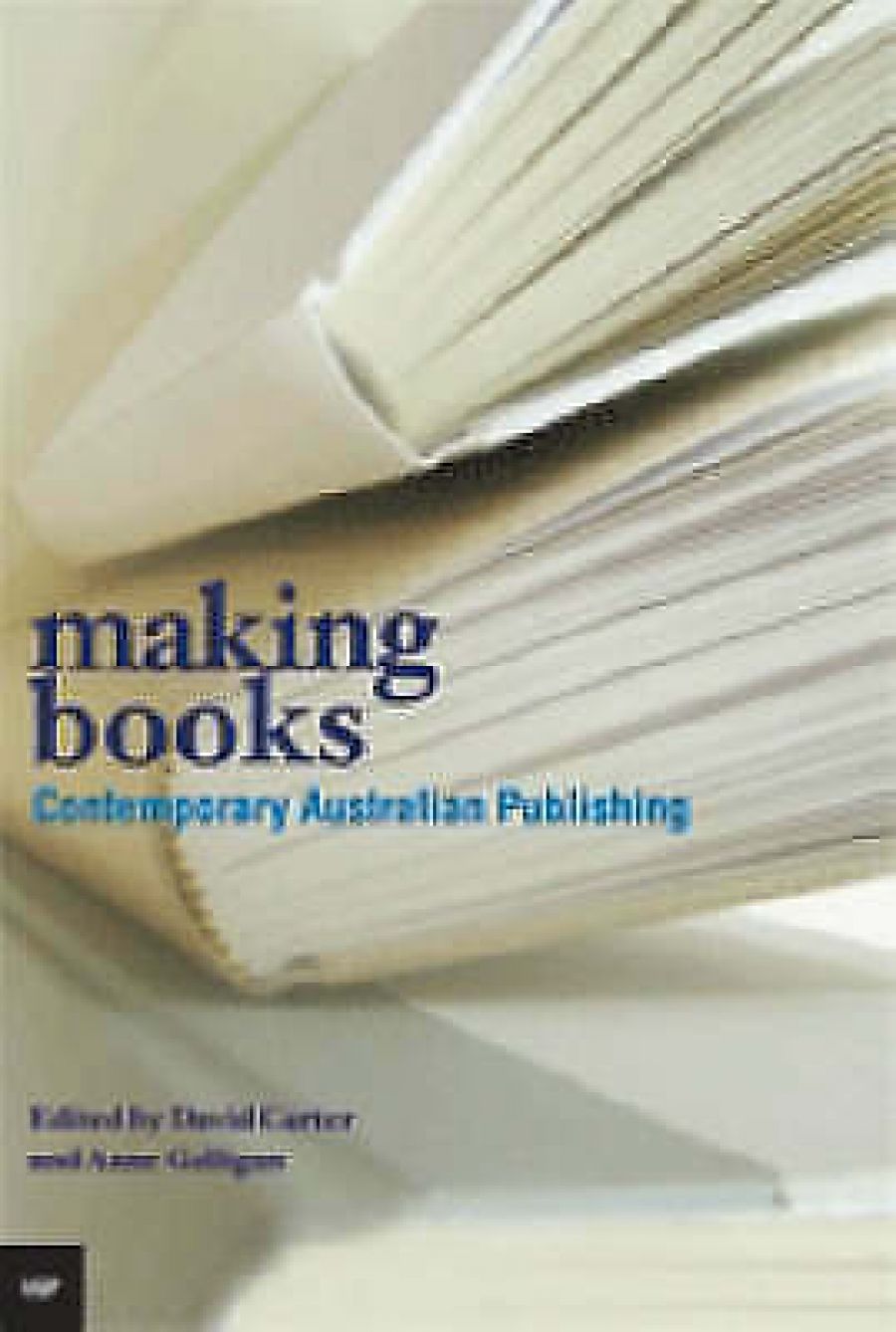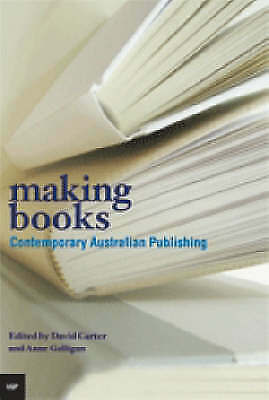
- Free Article: No
- Contents Category: Publishing
- Review Article: Yes
- Article Title: The Father of All Media
- Online Only: No
- Custom Highlight Text:
Until the last decade, there has been very little serious scholarly interest in Australian book publishing. Indeed, when I began lecturing in this discipline in 2001, there was no historical or contemporary overview that could be recommended to my students beyond the entry in the Australian Encyclopedia. However, with the recent dramatic growth in Communications courses, and spurred on by projects such as the History of the Book in Australia (HOBA), this situation has suddenly changed. UQP has already published two of the three promised HOBA volumes on the history of Australia’s print culture. Now we have, from the same publisher, a new collection of scholarly articles, which is undoubtedly superior to Paper Empires: A History of the Book in Australia 1946– 2005 (2006), the HOBA volume that dealt inter alia with contemporary publishing. Making Books: Contemporary Australian Publishing is less impressionistic and more systematic in its approach.
- Book 1 Title: Making Books
- Book 1 Subtitle: Contemporary Australian publishing
- Book 1 Biblio: UQP, $39.95 pb, 416 pp
- Book 1 Cover Small (400 x 600):

- Book 1 Cover (800 x 1200):

That’s the good news. However, there remains a difficulty. Scholars are expert in sifting through the data and the public utterances that throw light on their chosen subject, but, where they have insufficient direct experience in the discipline, they can miss some of the nuances. Their dogged research is at times handicapped by dodgy and self-serving statistics. They occasionally mistake the rhetoric of active participants for a mother-lode of truth. Making Books rarely shows insight into whether the criticisms of Australian book publishing it articulates are peculiarly Australian or simply features of global publishing, or indeed persistent features of the interface between capitalism and culture.
Making Books begins by combining the turnover of publishers and booksellers, to indicate the value of books to the community and the importance of this cultural sector. Of course, this is a kind of ‘double dipping’, since many book sales contribute to both these turnover figures. Surely The Word does not require such innumeracy to bolster its cultural importance? Misreading of data is a glaring problem throughout this collection.
Few of its contributors show any comprehension of the quotidian hand-to-hand combat between Australian publishing’s leading practitioners, whose public utterances usually have more to do with maintaining a high profile for their brand (which may be their imprint or their own reputation, or both) than a stern devotion to the truth. Academics read the pronouncements, but seem unable to grasp the context. One of the more sublime moments is a 2001 quote from Carol Davidson, then publisher at UQP, pouring utter scorn on the multinationals. In 2001 Ms Davidson, like a proud hen, was holding UQP’s chief hatchling, Peter Carey, protectively against all would-be predators. These days she is a senior executive at Random House Australia, which ultimately lured Carey from the Brisbane roost. No doubt she sings a different song now, and rightly so.
What is peculiar to Australian publishing, and what is typical of international publishing? For example, I can get nostalgic that the great Australian imprints of my earliest years – Lansdowne, Cheshire, Rigby, Angus & Robertson, etc. – no longer exist. By the same token, I could lament that the talismanic British firms of Gollancz or Eyre & Spottiswoode or Cassell no longer exist. For more than a hundred years, book publishing everywhere has been a restless scene of birth, death, merger, takeover and occasionally reincarnation. Great companies are often the creations of inspiring individuals, whose energy ultimately proves finite.
Similarly, the decline of the backlist may not have much to do with the philistinism of Australian publishers. With more than 100,000 new English-language books being unleashed onto the market each year (partly as a direct result of new technology, which makes viable smaller and smaller print runs), and with limited space in bookshops, that is the way it is worldwide. The English language is so dynamic that subtle changes in linguistic usage and cultural sensibility simply put older titles out of the comfort zone of the general reader. Indeed, when so-called classics do manage to get a reprise – as with the 2004 Classic Australian Works series, initiated jointly by the Copyright Agency Limited and Sydney University Press – this feat is applauded by academics and writers, but basically remains unsupported by the wider public.
The typical critique of book publishing rarely acknowledges that the daily balancing act performed by publishers is no different in kind from that performed by film-makers, record and theatre producers, and architects. Wherever artistic activity requires serious money for its realisation, there are going to be commercial considerations. That is not to say that commerce should prevail, but at least it would be nice for the efforts of Australian publishers to be recognised. Even the large multinationals manage, somehow or other amid the chaos, to produce books that are highly original and intellectually challenging.
There is much sympathy expressed in Making Books for ‘mid-list authors’, which is usually a polite way of describing authors who are not widely appreciated. Publishers are conscious of the fact that some mid-list authors, particularly those who are young and have many more books left in them, may later become best-sellers (Louis de Bernières seems to be the example most often trotted out; but of course there is the infamous Dan Brown and, in Australia, Peter Temple). The art of publishing is the art of predicting public taste, either in the short or long term, but it is harsh to want to shame publishers for not persisting with authors for whom there is no public demand and, they fear, never will be.
Throughout, there is an assumption that we all know what ‘literary fiction’ is – a distinctly pre-postmodern notion, surely – and that ‘Australian book’ needs no definition whatsoever. Belatedly, David Carter attempts to come to terms with what is or is not literary fiction, but then baulks at the hurdle. At first, he wants to rely on the fact that publishers categorise some of their books in this way, but then he fails to recognise that their definition will relate to what is good for the book and author, not to some higher truth. Being labelled ‘literary’ may put too much lead in the saddle-bag for some books.
Carter then states a preference for the AustLit categorisation, but this seems to exclude any book that is otherwise categorised as Romance, Crime, Science Fiction, Young Adult, etc.. AustLit is only categorising what it believes are Australian novels, but you would need to crawl into the very bowels of the data if you wanted to discover whether D.B.C. Pierre or Geraldine Brooks are to be regarded as Australian, or whether Peter Carey’s departure from UQP or J.M. Coetzee’s residency in Adelaide are deemed to change their status. In much of the data publicly available, ‘Australian books’ includes books acquired from foreign publishers and translated here; much more problematically, it usually includes foreign books acquired by Australian imprints (Allen & Unwin, Scribe, Black Inc., etc.) and thus written, edited and typeset overseas.
The ambivalent attitude of our local authors to Australian-owned publishing houses is the elephant in the literary bedroom. Actors, playwrights and composers have traditionally been much more vocal than Australian authors in support of the Australian-controlled infrastructures they feel they need to support their art forms. I know of no successful Australian author who has consistently argued the case for Australian-owned publishing, nor one who has remained loyal to a small publisher when more lucrative opportunities beckoned. Most are thrilled to be nurtured by large conglomerates that may offer them a multi-media breakout. Who can blame them, despite the rarefied arguments raised in this book that such publishing houses are ineluctably imbued with philistinism?
The critique of contemporary Australian book publishing reaches its apotheosis in the contribution of Mark Davis (‘The Decline of the Literary Paradigm in Australian Publishing’), which begins by comparing best-seller lists before and after the advent of BookScan. Davis seems to believe that this comparison indicates a recent dumbingdown of Australian taste, when, arguably, there may have been no changes whatsoever and BookScan may simply be documenting more accurately the long-standing dominance of middle-brow books. He harks back to the great period of cultural renewal that ran for maybe fifteen years from 1970; in seeking the reasons for its decline, he does not mention a similar phenomenon in Australian theatre and film.
Davis claims that high advances are not being offered to new or literary writers (perhaps he should swap notes with Tim Winton or Kate Morton). He laments the decline in the number of entries to the Miles Franklin Award, without mentioning that its entry criteria continue to make more and more fine novels ineligible. He does not offer any view as to whether Peter Temple and Shane Maloney, say, should be excluded from the literary pantheon because they write genre fiction, or whether Wendy Harmer should be excluded because she is funny. Nor does he engage with the wider question of whether it is in fact the distrust by young cultural consumers of the earnest and the difficult that has caused a worldwide decline in appreciation of classical and jazz music, art-house movies and printed poetry.
Davis finds it more satisfying to dwell on the fact that books’ share of the leisure spend has declined in recent years than the alternative fact: that the number of books sold has climbed annually (in a leisure segment that has been galloping). He finds it more comfortable to give capitalism a clip over the ears than to inquire into the bewildering changes in taste, across the cultural board, with which publishers have to contend.
Of course, the chief glory of Making Books is that it finds space for so many diverging viewpoints. Immediately succeeding Mark Davis’s purblind polemic is a strong corrective from Richard Flanagan, who returns from abroad with the news that the problem is worldwide and that ‘Australian publishing over the last 30 years is a cultural success story, perhaps our greatest, that for some peculiar reason we choose not only to ignore but to denigrate’. His views should be read closely by all naysayers before they utter another syllable.
The first third of this book is a fierce debate on the state of book publishing in Australia in the first decade of the new millennium. After that it offers important information on new technology and various specialisations, from feminist to food publishing. Some of this is up-to-date, and some not. The sale of Lothian to Hachette Livre gets in by the skin of its teeth, but not the sale of Lonely Planet, nor changes at Borders and elsewhere in the retail trade. If Anthony May had been able to take in hand Peter Temple’s recent overseas success, he might have been forced to reassess the thrust of his argument about Australian crime novels. But them’s the breaks.
In a decade of extraordinary evolution for all media, the Father of All Media – the book – has so far been spared the life-threatening traumas that are presently engulfing the record and television industries. But there is dramatic and fast-paced change nonetheless. For those who love the book, and are not so poisoned by nostalgia as to refuse to face the future, here is a valuable overview of where we are. It may yet help us discover where we are headed.


Comments powered by CComment